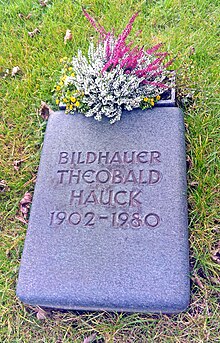Theobald Hauck
Theobald Hauck (born March 16, 1902 in Maxdorf ; † December 6, 1980 in Maxdorf) was a German sculptor and draftsman.
Live and act
He was born in Maxdorf, Palatinate , and attended secondary school in Ludwigshafen am Rhein from 1912 to 1919 . From 1919 to 1921 Hauck studied with Wilhelm Gerstel at the Karlsruhe Art Academy . From around 1920 he began his independent artistic work, his works have been shown at exhibitions, among other things. In 1922/1923 he followed Gerstel to the Berlin Art College in order to receive further training from him. Finally, Theobald Hauck attended the Academy of Fine Arts in Munich in 1923 and 1924 , where Hermann Hahn was his teacher. In 1924 he also went on a study trip to Rome and Naples .
From 1926 to 1929 Hauck ran a studio in Ludwigshafen-Oggersheim , in 1930 he moved to his home town of Maxdorf, where he stayed for life. During this time, the sculptor worked for the architect Heinrich Müller in his post office buildings in the Palatinate (including the post office in Mutterstadt ), but also a busy producer of sculptures, especially for war memorials , as well as on the subject of labor and rural life. In 1934 he won the competition from Westmark Verlag on the subject of “1. May"; At the Great German Art Exhibition , his bronze sculpture “Der Schnitter” caught the attention of Adolf Hitler , who subsequently bought it. During the Nazi era, Hauck officiated as Maxdorf local group leader of the NSDAP and 3rd mayor of Lambsheim , responsible for Maxdorf (at that time still a district of Lambsheim). From 1934 to 1939 he acted within the Reich Chamber of Culture , succeeding Albert Haueisen , as head of the Reich Chamber of Fine Arts in the Westmark region .
From 1939 to 1945 Theobald Hauck took part in World War II as a soldier , from 1945 to 1947 he was a Soviet prisoner of war. After returning home, he resumed his art work in Maxdorf, in 1954 he was a co-founder of the Palatinate Artists' Cooperative. In his later work, turning to more and more abstract forms, he again created numerous works in public space.
The community of Maxdorf made him an honorary citizen and on his death he was given an honorary grave in front of the funeral hall of the Maxdorf cemetery, near a figure of St. Francis he had created .
Works
(Selection)
- War memorial in Altrip (1926/27)
- Resurrection relief, cemetery chapel, Ludwigshafen-Friesenheim (1927)
- Figure of Mercury at the Post Office in Ludwigshafen-Oggersheim (1927)
- War memorial in Otterstadt (1929)
- War memorial in Lambsheim (1931)
- War memorial in Neuhofen (1934)
- War memorial in Römerberg , Berghausen district (1936)
- War memorial in Bobenheim-Roxheim , Roxheim district (1937)
- War memorial in Maxdorf (1963)
- Stone sculpture "Sankt Franziskus", cemetery in Maxdorf (1971)
- Symbol wall in the courtyard of the school center in Maxdorf (1977)
- Fountain at the district indoor pool in Maxdorf (1977)
- Metal stele in front of the Maxdorf municipal administration (1977)
Gallery of works
literature
- Viktor Carl: Lexicon Palatinate Personalities Hennig Verlag, Edenkoben 2004, ISBN 3-9804668-5-X , p. 329.
- Karl Schultz: The Sculptor Theobald Hauck In: The new art archive , issue 13, 1962.
- Paul Platz: Theobald Hauck - Art in Public Space , Heimatjahrbuch Nr. 19 of the Rhein-Pfalz district administration, Ludwigshafen, 2002, p. 138 u. 139
Web links
- Data page of the Academy of Fine Arts Munich, on Theobald Hauck
- Biographical website
- Theobald Hauck in Rhein-Neckar-Wiki
- Website on personalities from the Rhein-Pfalz-Kreis (Theobald Hauck can be opened)
Individual evidence
- ^ Wolfgang Werner: The architect Heinrich Müller and the Bavarian Post Building School in the Palatinate. KIT Scientific Publishing, Karlsruhe 2012, ISBN 3-86644-790-6 , p. 84 ( online )
- ↑ Wolfgang Kunz, Henning Cramer, Wolfgang Fluck: Maxdorf, Geschichte und Natur , Knecht-Verlag Landau, 2014, ISBN 978-3-939427-19-3 , p. 83
| personal data | |
|---|---|
| SURNAME | Hauck, Theobald |
| BRIEF DESCRIPTION | German sculptor and stonemason |
| DATE OF BIRTH | March 16, 1902 |
| PLACE OF BIRTH | Maxdorf |
| DATE OF DEATH | December 6, 1980 |
| Place of death | Maxdorf |











